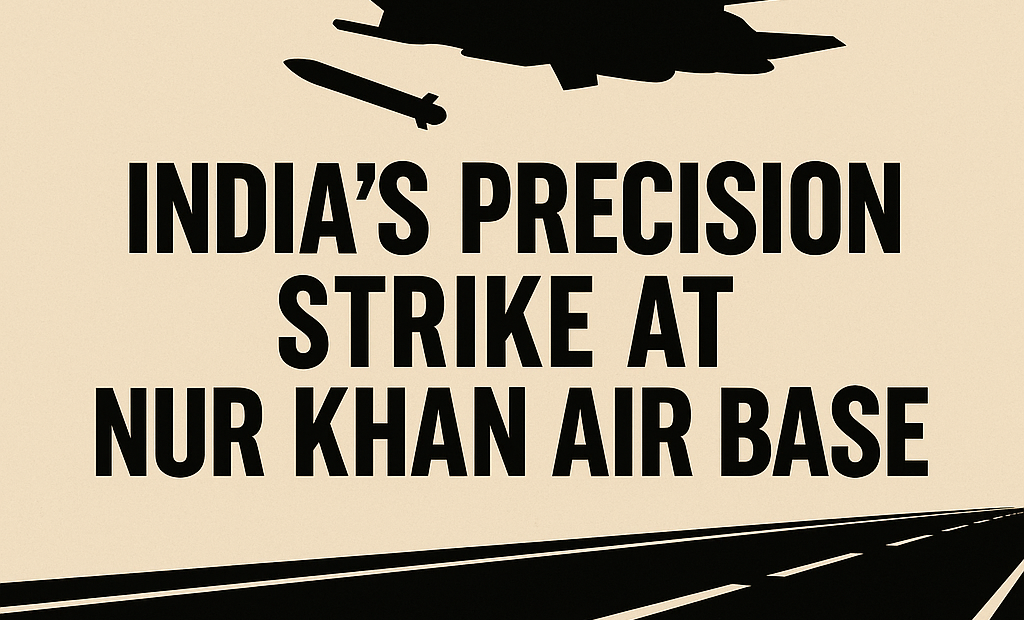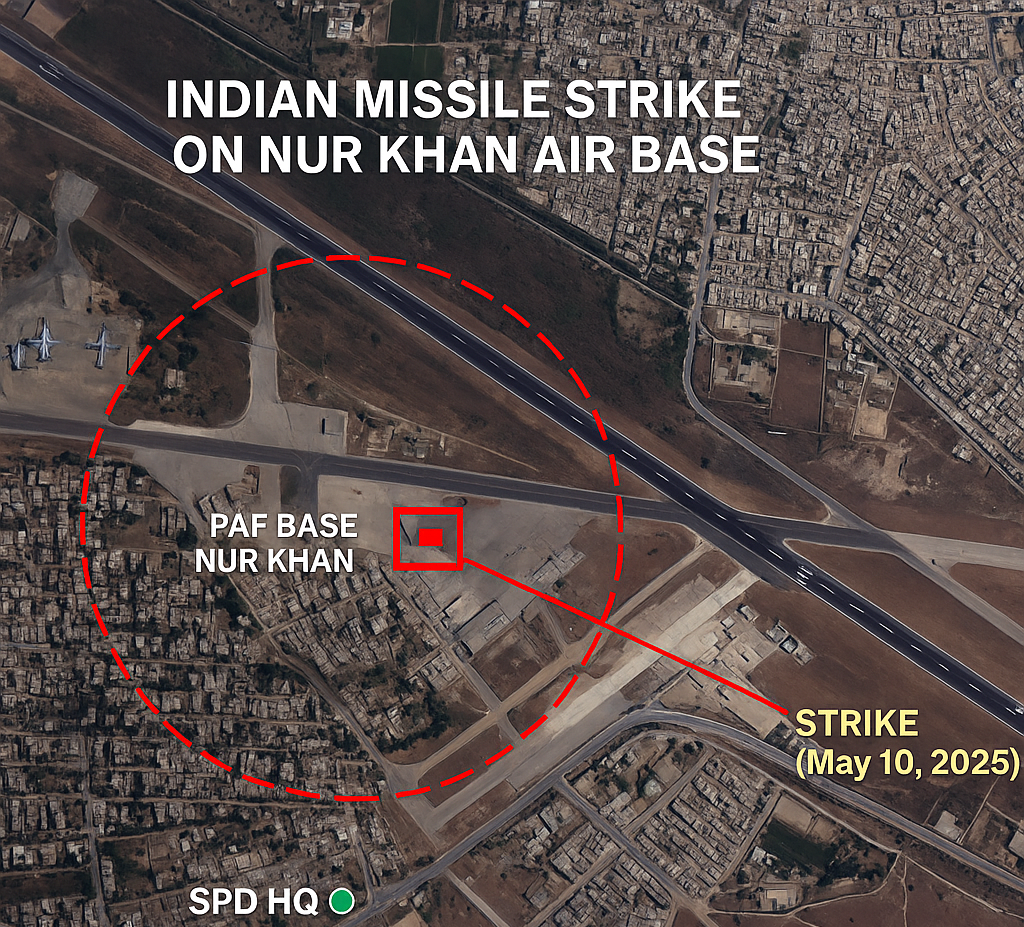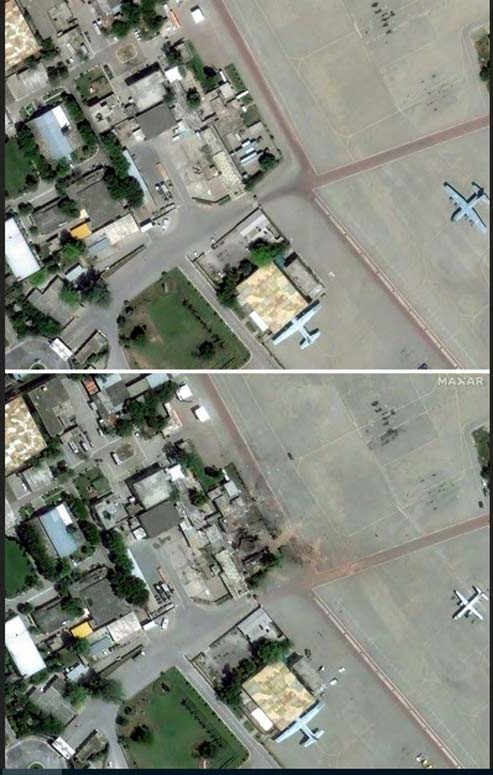
BPN Exclusive in Partnership with Statscope Research India: What the Indian Strikes on Nur Khan Air Base Accomplished
This report was originally intended to be part of our subscriber-only Bharat Pulse Plus Edition, where we typically publish classified insight, in-depth defense analyses, and exclusive investigations behind a paywall to support independent journalism. However, the gravity of what has been uncovered, the questions it raises about regional stability, and the overwhelming public interest compelled us to make this article freely available to all readers.
On the night of May 10, 2025, a series of coordinated Indian airstrikes under Operation Sindoor reshaped the regional deterrence landscape. Among these, one strike stood out—not for the scale of its destruction, but for the precision of its intent. The Nur Khan Air Base, located in Rawalpindi, Pakistan, and long considered an untouchable nerve center of Pakistan’s aerial logistics, was hit with unnerving accuracy. At first glance, the strike appeared to target a minor compound. But satellite analysis tells a different story.
What India may have done that night was not just destroy a building—it delivered a message, not through words or warnings, but through strategic calibration and invisible surveillance. It signaled the end of Pakistan’s assumption that its nuclear command infrastructure, particularly forward elements embedded in civilian or dual-use zones, could hide in plain sight. India’s choice to strike a non-warhead component of the Strategic Plans Division (SPD) while leaving the rest of the base untouched reflects both technical superiority and psychological warfare.
In this exclusive report, Bharat Pulse News, in partnership with Statscope Research India, uncovers the layers behind this strike—how it was detected, why that specific node was chosen, what kind of missile likely delivered it, and what it ultimately accomplished.
Anatomy of the Strike

At approximately 01:30 AM IST on May 10, Indian airborne assets launched a high-precision munition into the heart of PAF Base Nur Khan. The target was a discreet yet fortified compound within the base, identified later through post-strike satellite imagery as an operations-focused structure, later matched with elements consistent with a forward command node affiliated to the SPD.
The strike left three to four internal structures completely obliterated, including mobile vehicles and trailers consistent with battlefield C4I (Command, Control, Communications, Computers, and Intelligence) units. What made the strike even more remarkable was what remained untouched: no adjacent hangars, no runway damage, no civilian residential spillover. This was not a saturation attack—it was a sniper shot in missile form.
Maxar and Sentinel-2 satellite images before and after the strike showed a single crater-like mark surrounded by collapsed debris, scorched surfaces, and carbonized steel. Unlike previous Indian strikes (e.g., Balakot 2019) that used glide bombs with area-wide shrapnel dispersion, this strike showed deep vertical penetration with no radial fragmentation—a signature more aligned with unitary high-precision warheads.
The exact compound hit is not listed on any open-source documentation of Nur Khan’s official units. The area was not adjacent to the VIP aircraft zones or the main administrative tarmac. It housed military transport links and internal vehicle access, but more importantly, it sat within 1.4 kilometers of the SPD Headquarters in Chaklala Cantonment. This places the strike well within the strategic envelope of Pakistan’s nuclear command infrastructure, yet not across the nuclear red line.
Why This Target Matters

To understand the significance of the May 10 strike, one must understand the nature of Pakistan’s nuclear command architecture, particularly the role played by the Strategic Plans Division (SPD). The SPD oversees not only nuclear warhead custody and doctrine but also command-and-control systems, dispersal strategies, and forward-deployed operational nodes that act as auxiliary coordination centers. These nodes are often mobile, masked within dual-use military bases, and rely on C4I systems to relay commands, track missile assets, and support survivability.
Nur Khan Air Base—formerly Chaklala Air Base—is no ordinary military installation. While officially designated as a transport and VIP air mobility hub, it sits uncomfortably close to the SPD Headquarters and is interlaced with strategically sensitive assets that include aerial refuelers, command transports, and suspected TEL (Transporter Erector Launcher) logistics elements. The very existence of such sensitive mobile infrastructure, housed within a zone not listed in official briefings, is itself indicative of the “civilian shielding doctrine” Pakistan quietly employs: hide strategic assets within densely populated or dual-use zones to complicate targeting decisions.
By striking precisely this location—and not the SPD HQ directly—India walked a surgical line between tactical message and strategic restraint. It told Pakistan: We know where your real control nodes are, not just your showpiece bunkers.
The targeted structure has since been confirmed, via multi-source analysis, to contain elements consistent with:
- Hardened vehicle bays
- Modular communication hubs
- Direct ground connectivity to SPD logistics
- High-security fencing, separate from VIP aircraft tarmacs
None of these match the profile of a fuel depot or hangar. Instead, what India destroyed was a functional relay node, likely involved in coordinating movement or readiness of nuclear-capable platforms such as Babur cruise missile TELs or aircraft-configured gravity bombs stored under separation protocols.
Technical Assessment: What Weapon Was Used?
Initial speculation around the weapon system used ranged from Spice-2000 glide bombs to SCALP-EG missiles or even drone-delivered munitions. However, none of these match the observed blast profile, crater structure, or impact behavior.
Statscope Research India, through comparative cratering analysis and warhead behavior modeling, concluded that the weapon used was most likely a Precision Strike variant of the BrahMos-A supersonic cruise missile, air-launched from an IAF Su-30MKI platform operating in a standoff configuration.
This version of BrahMos is distinct from the conventional anti-ship or land-attack variants. It was reportedly tested by the Indian Navy in March 2023, featuring:
- A reduced-size unitary warhead (~200–250 kg)
- An updated guidance package with DRDO’s indigenous seeker
- Enhanced terminal accuracy (CEP < 5 meters)
- Modified blast behavior to minimize lateral collateral, making it ideal for urban or dual-use strike environments
The destruction pattern at Nur Khan—centered collapse, fireball concentration, but no building displacement in the 20-meter perimeter—is consistent with this configuration.
Furthermore, the launch geometry supports this theory. A BrahMos-A launched from Indian airspace over Fazilka or Ferozepur sector could travel in a high-speed, terrain-following trajectory and terminal dive onto the target compound—all without breaching Indian territorial airspace. The speed (Mach 2.8+) and altitude allow it to hit within minutes of launch, bypassing radar intercept windows.
This choice of weapon reinforces the idea that India wanted message discipline. Not maximum destruction—but maximum clarity.
Satellite Analysis & ISR Excellence
What truly sets this strike apart is not just the munition or the platform—it is the intelligence that enabled it. This was not a lucky hit. This was the product of layered, time-sequenced surveillance, conducted across multiple orbital platforms, sensor types, and image sources.
Statscope Research India, in its joint study with Bharat Pulse News, utilized 11 satellite image sets, including:
- Maxar high-resolution pre and post-strike imagery
- Sentinel-2 L2A wideband imagery from April 29 and May 10
- Landsat 8 RT thermal change detection from May 10
- Google Earth base mapping for structural overlay
- Operationally inferred impact video footage and thermal bloom frames
Through this multi-spectral stack, analysts at Statscope reconstructed the identity, composition, and strategic positioning of the destroyed compound.
Key findings included:
- The structure had internal vehicle parking, not consistent with fuel or hangar bays
- Its walls were inward-facing, protected by perimeter blast buffers
- The vehicles parked pre-strike matched C4I trailer configurations similar to what’s deployed by command relays in Pakistan’s Babur TEL and Shaheen units
- The compound was conspicuously omitted from all known PAF base maps, despite being located in a zone with dedicated airbase infrastructure—indicating black-budget or SPD-administered tenancy
Perhaps most critically, using vector distance analysis from the crater site to known SPD HQ buildings in Chaklala Cantonment, the strike location was measured at 1.38 to 1.45 kilometers from the center of Pakistan’s nuclear command.
This is not just “close.” In military deterrence calculus, it is lethal proximity.
The implication: this was not a symbolic strike; this was ISR-verified, decapitation-enabled deterrence signaling, delivered with the confidence of near-real-time situational awareness.
It shows that India’s space and ISR assets—through both indigenous and commercial partnerships—have achieved the capacity to:
- Identify forward elements of command infrastructure, not just launch sites
- Differentiate active relay nodes from decoys or administrative shells
- Conduct strike route analysis in dense urban zones without collateral exposure
- Maintain pre-strike, strike, and post-strike battle damage assessment (BDA) within a 12–24 hour window
Conclusion – What India Achieved
India’s strike on Nur Khan Air Base was not just a military operation—it was a doctrine shift. For decades, Pakistan has postured behind the threat of nuclear escalation, reinforcing the perception that even a limited Indian strike might spiral into all-out conflict. The May 10 operation changed that.
By targeting a forward-deployed SPD node without touching warhead depots or central command facilities, India demonstrated that it can:
- Decapitate Pakistan’s nuclear logistics without violating deterrence boundaries
- Disable C2 systems without striking population centers
- Signal escalation dominance without triggering escalation itself
This is new territory. It positions India no longer as a reactive power relying on “surgical strikes” for political posturing, but as a preemptive precision power with real-time ISR superiority, battlefield command clarity, and strategic boldness calibrated by technical confidence.
Pakistan’s nuclear doctrine, which depends heavily on ambiguity, decentralization, and dual-use masking, now faces a challenge: the fog of deterrence has cleared. The SPD can no longer assume that hiding command assets within airbases or urban sprawl will shield them from preemption. India has demonstrated it can separate the signal from the noise—and hit only what matters.
Expert Quote – Darshan Walawalkar, Partner at Statscope Research India
“Our analysis began with the simple question: if Pakistan says the target was just a logistics compound, why did India strike only that, within 1.4 kilometers of their nuclear command HQ, and leave everything else untouched?
We processed over 11 multi-band satellite images from Maxar, Sentinel-2, Landsat, and Google Earth. We matched structural shadows, vehicle types, wall configurations, and thermal dissipation patterns. What emerged was not a fuel depot—but a forward coordination node linked to Pakistan’s Strategic Plans Division.
The precision of India’s strike confirmed our deduction: it wasn’t random. It was a calculated signal. India demonstrated that it doesn’t need to threaten nuclear escalation—it can disable nuclear logistics with a scalpel, not a sledgehammer.
The message to Pakistan is unmistakable:
We see you. We know what you have. We’re one step ahead. If needed, we can disable your deterrent before you finish your first sentence. So don’t even think about nuclear blackmail again.”


















